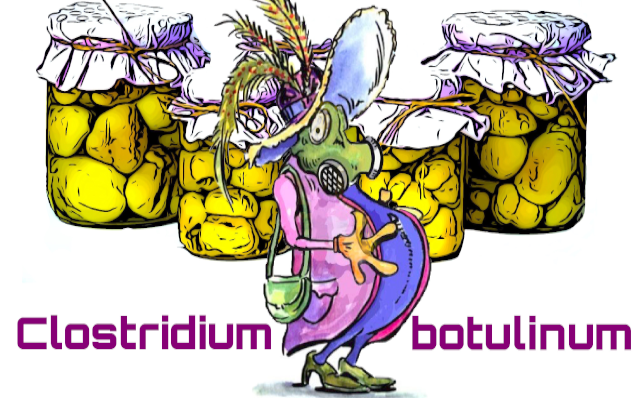A recent note from the Istituto Superiore di Sanità (ISS) highlights that Italy is the European country with the highest number of botulism cases. 342 cases, between 1986 and 30.6.19, involved a total of 501 people. (1) Its best-known form is the foodborne form, to which are added the infant and wound forms. Attention should be paid to homemade preserves and honey for infants.
Food Botulism
Contamination of food products by Clostridium botulinum, the agent of botulism, represents one of the most serious threats to food safety. C. botulinum is an anaerobic bacterium capable of producing extremely heat-resistant spores and toxins with neurotrophic activity. Botulinum toxins are inactivated at a temperature of 80 °C for at least 10 minutes, while for spores the inactivation temperatures are significantly higher, as we shall see.
Among food poisonings, botulism is undoubtedly the most dangerous as neurotoxins are capable of blocking the activity of motor neurons, resulting in flaccid paralysis of various muscle districts. Symptoms develop fairly quickly because the toxins are already present within the food product. They appear on average 12-36 hours after ingestion of the contaminated food and can extend, rarely, up to 15 days. The paralysis has a descending course, with initial involvement of the eye muscles and subsequent visual disturbances (diplopia, or double vision, and blurred vision), followed by paralysis of the muscles of swallowing and speech, incoordination of movements, and paralysis of the upper and lower limbs. Depending on the dose of toxin ingested, clinical symptoms can range from very mild to very severe. They can also end in the person’s death (in about 5 percent of cases)-especially in patients not undergoing intensive care-due to paralysis of the diaphragm and respiratory muscles.
Foods at risk
Clostridium botulinum spores can contaminate a wide range of products. First and foremost are the vegetables,as they are in contact with potting soil, soil and dust. The wide distribution of the spores means that they can be ingested by a variety of animals and are thus found in the intestines of many mammals and fish, as well as in the sea and lake bottoms. Vegetables are particularly susceptible to contamination because, if soiled with soil and not thoroughly washed, C. botulinum spores persist there for a long time.
Some home preserves – made from mushrooms, eggplant, olives, etc. – Are particularly at risk. To the extent that they are not subjected-as is industry practice-to temperatures that guarantee the destruction of spores (121°C for at least 3 minutes). The subsequent addition of oil creates the anaerobiosis necessary for the development of the microorganism, which germinates from the spore and produces the neurotoxins. Only conditions of high acidity (pH below 4.6) can hinder clostridium development and botulinum toxin production.
Botulinum
, the name given to the bacterium, on closer inspection is derived from the Latin botulus, meaning sausage. The first often fatal cases of botulinum intoxication were in fact reported following the consumption of pork sausages or blood sausages, where clostridium could develop. Because spores can remain in the intestines of many mammals, pig slaughtering can lead to contamination of meat. And it is precisely to prevent the germination of spores-and the subsequent development of Clostridium botulinum, with the production of the neurotrophic toxins-that certain additives with a preservative function (sodium and potassium nitrites and nitrates) are routinely added to various meat products (e.g., the salami, cooked hams, mortadella, sausages, etc.). (2)
Infant botulism and wound botulism
Infant botulism is particularly insidious because it affects children younger than 1 year of age, particularly between 3 and 6 months of age. It is often the cause of sudden, crib deaths of babies as young as a few months old. Unlike food botulism, the disease is not due to ingestion of preformed botulinum toxins but to ingestion of the spores alone. One of the foods most at risk for infants is honey, which is sometimes rich in spores that-when ingested-germinate in the baby’s intestines and produce neurotoxins in situ. In the child over one year of age-as well as in the adult-the intestinal bacterial flora, on the other hand, prevents the development of vegetative forms, so any spores ingested do not cause harm.
Wound botulism, on the other hand, is caused by the penetration of spores (found in soil and dust) within fairly deep, usually lacerated wounds that have not been properly disinfected. Spore germination gives rise to neurotoxin-processing bacteria, facilitated in their development by the scarcity of oxygen in the deep parts of the injured tissue. The incubation period can range from 4 to 14 days, and the symptoms are the same as those of the alimentary form. Cases of wound botulism have also been described in drug addicts (due to poor hygiene in syringe use).
Silvia Bonardi and Dario Dongo
Notes
(1) Superior Institute of Health, ISS. (2010). Focus food botulism, https://www.iss.it/focus/-/asset_publisher/92GBB5m5b1hB/content/id/4542962
(2) Research and development in recent years has been directed toward the possible use of plant ingredients with preservative functions. See previous articles
– Natural preservatives in meats, https://www.greatitalianfoodtrade.it/etichette/conservanti-naturali-nelle-carni,
– plant extracts with preservative functions, short-circuited in Europe, https://www.greatitalianfoodtrade.it/consum-attori/estratti-vegetali-nelle-carni-cortocircuito-in-europa,
– Natural preservatives in meats, prickly pear. V. https://www.greatitalianfoodtrade.it/tecnologia-alimentare/conservanti-naturali-nelle-carni-il-fico-d-india-studio-università-di-catania









